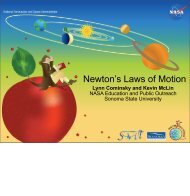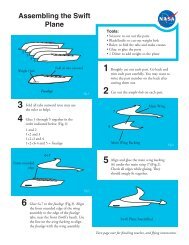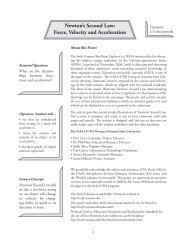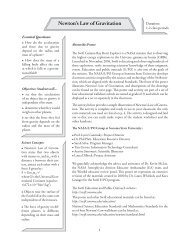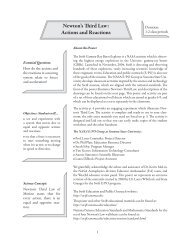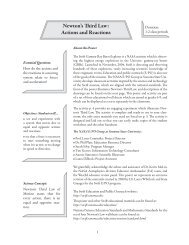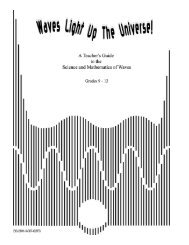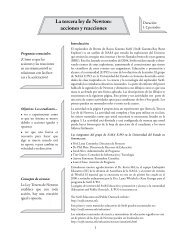Newton's Second Law: Force, Velocity and Acceleration - Swift
Newton's Second Law: Force, Velocity and Acceleration - Swift
Newton's Second Law: Force, Velocity and Acceleration - Swift
Create successful ePaper yourself
Turn your PDF publications into a flip-book with our unique Google optimized e-Paper software.
Newton’s <strong>Second</strong> <strong>Law</strong>:<strong>Force</strong>, <strong>Velocity</strong> <strong>and</strong> <strong>Acceleration</strong>Duration:2-3 class periodsAbout this PosterEssential Question:What are the relationshipsbetween force,mass, <strong>and</strong> acceleration?Objectives: Students will…• see that an unbalancedforce acting on a mass willaccelerate it.• relate the motion <strong>and</strong>velocity of an object to itsacceleration.• interpret graphs of simplemotions (optional).The <strong>Swift</strong> Gamma-Ray Burst Explorer is a NASA mission which is observingthe highest energy explosions in the Universe–gamma-ray bursts(GRBs). Launched in November, 2004, <strong>Swift</strong> is detecting <strong>and</strong> observinghundreds of these explosions, vastly increasing scientists’ knowledge ofthese enigmatic events. Education <strong>and</strong> public outreach (E/PO) is one ofthe goals of the mission. The NASA E/PO Group at Sonoma State Universitydevelops classroom activities inspired by the science <strong>and</strong> technologyof the <strong>Swift</strong> mission, which are aligned with the national st<strong>and</strong>ards.The front of the poster illustrates Newton’s <strong>Second</strong> <strong>Law</strong>, demonstratinghow a mass is accelerated when a force is applied to it. Descriptions of thedrawings can be found on the next page. This poster <strong>and</strong> activity are partof a set of four educational wallsheets which are aimed at grades 6-9, <strong>and</strong>which can be displayed as a set or separately in the classroom.The activity provides several simple illustrations of Newton’s <strong>Second</strong> <strong>Law</strong>.The activity is complete <strong>and</strong> ready to use in your classroom with onlypaper <strong>and</strong> pencils. The activity is designed <strong>and</strong> laid out so that you caneasily make copies of the student worksheet <strong>and</strong> the other h<strong>and</strong>outs.The NASA E/PO Group at Sonoma State University:• Prof. Lynn Cominsky: Project Director• Dr. Phil Plait: Education Resource Director• Sarah Silva: Program Manager• Tim Graves: Information Technology Consultant• Aurore Simonnet: Scientific Illustrator• Laura Dilbeck: Project AssistantScience Concept:Newton’s <strong>Second</strong> <strong>Law</strong> tellsus that a net force actingon an object will changeits velocity by changingeither its speed or itsdirection or both.We gratefully acknowledge the advice <strong>and</strong> assistance of Dr. Kevin McLin,the NASA Astrophysics division Educator Ambassador (EA) team, <strong>and</strong>the WestEd educator review panel. This poster set represents an extensiverevision of the materials created in 2000 by Dr. Laura Whitlock <strong>and</strong> KaraGranger for the <strong>Swift</strong> E/PO program.The <strong>Swift</strong> Education <strong>and</strong> Public Outreach website is:http://swift.sonoma.eduThis poster <strong>and</strong> other <strong>Swift</strong> educational materials can be found at:http://swift.sonoma.edu/education/National Science Education St<strong>and</strong>ards <strong>and</strong> Mathematics St<strong>and</strong>ards forthe set of four Newton’s <strong>Law</strong> wallsheets can be found at:http://swift.sonoma.edu/education/newton/st<strong>and</strong>ards.html1
Student H<strong>and</strong>out: Newton’s <strong>Second</strong> <strong>Law</strong>: <strong>Force</strong>, <strong>Velocity</strong> <strong>and</strong> <strong>Acceleration</strong>-Extension ActivityProcedure: Action <strong>Force</strong> (Extension)Examine the six cartoon drawings, <strong>and</strong> the six different sets of graphs on the attached page. Thereare three cartoons that show different possible motions of a ball, <strong>and</strong> three cartoons that show differentmotions of a car. Each set of graphs contains the following: x-position vs. time, y-position vs.time, x-velocity vs. time, y-velocity vs. time, <strong>and</strong> acceleration (in either the x or y direction.)The goal is to match the cartoon drawings with the correct set of graphs that represent the motionshown in the cartoon.Explain:A) What type of motion does each cartoon represent?B) How did you decide what matches to make?C) For each cartoon, which graph was the most important in helping you to decide the match?D) Were there some graphs that did not help you very much? Which ones were they?E) In which of the above examples did the objects accelerate? How could you tell?F) Did any of the above examples accelerate in more than one direction?Post-activity Discussion:F boosterCompare <strong>and</strong> contrastcartoon 2 (girl throwing theball up into the air) to Fig. 1that shows the forces at thelaunch of the <strong>Swift</strong> satellite.Compare <strong>and</strong> contrast cartoon 3 (girlthrowing the ball sideways) to Fig. 2that shows the velocity <strong>and</strong> accelerationof <strong>Swift</strong> as it goes into orbit.F gravityV horaGirl 3Fig.2Fig.1 Girl 2http://swift.sonoma.edu8
Write your answer in the gray box below with the cartoon number that corresponds to the correct setof graphs. [Note: you may want to place the two pages together to help you do the comparison.]Aposition6543210x position vs. time- 0.5 1 1.5timeposition121086420y position vs.time- 0.5 1 1.5timevelocity121086420x velocity vs. time- 0.5 1 1.5timevelocity0- 2- 4- 6- 8- 10- 12- 14- 16y velocity vs. time0.5 1 1.5timeacceleration0- 2- 4- 6- 8- 10- 12y acceleration vs.time0.5 1 1.5timeBposition12108642x position vs. timeposition10.80.60.40.2y position vs.timevelocity12108642x velocity vs. timevelocity10.80.60.40.2y velocity vs. timeacceleration0- 1- 2- 3- 4- 5x acceleration vs.time0.5 1 1.5 20000- 60.5 1 1.5 2time0.5 1 1.5 2time0.5 1 1.5 2time0.5 1 1.5 2timetimeC6x position vs. time1y position vs.time8x velocity vs. time1y velocity vs. time6x acceleration vs.timeposition54321position0.80.60.40.2velocity7654321velocity0.80.60.40.2acceleration543210-0.5 1 1.5time00.5 1 1.5time0-0.5 1 1.5time00.5 1 1.5time0-0.5 1 1.5timeDposition10.80.60.40.2x position vs. timeposition654321y position vs.timevelocity10.80.60.40.2x velocity vs. timevelocity161412108642y velocity vs. timeacceleration0- 2- 4- 6- 8- 10y acceleration vs.time0.5 1 1.500.5 1 1.5time0-0.5 1 1.5time00.5 1 1.5time00.5 1 1.5time- 12timeEposition252015105x position vs. timeposition10.80.60.40.2y position vs.timevelocity12108642x velocity vs. timevelocity10.80.60.40.2y velocity vs. timeacceleration10.80.60.40.2x acceleration vs.time000000.5 1 1.5 2time0.5 1 1.5 2time0.5 1 1.5 2time0.5 1 1.5 2time0.5 1 1.5 2timeFposition10.80.60.40.20x position vs. time0.5 1 1.5timeposition121086420y position vs.time- 0.5 1 1.5timevelocity10.80.60.40.20x velocity vs. time0.5 1 1.5timevelocity0- 2- 4- 6- 8- 10- 12- 14- 160y velocity vs. time0.5 1 1.5timeacceleration0- 2- 4- 6- 8- 10- 12y acceleration vs.time0.5 1 1.5timeName: ________________________ Date: ______________ Period: _____9



